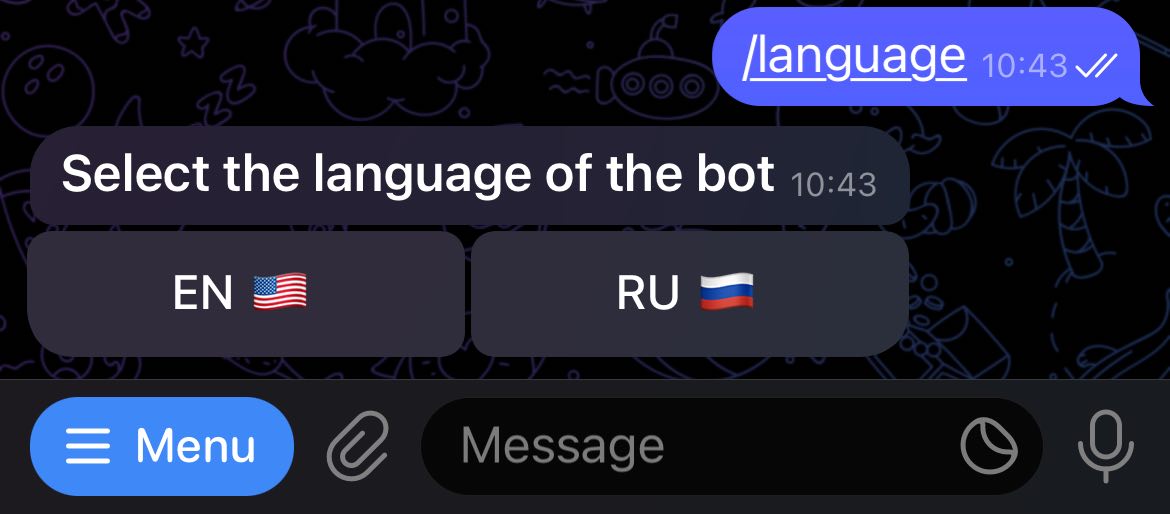- About the framework
- How to use
- Java 17
- Spring Boot
- Maven
- Telegram bot library
- Allows you to create a multilingual bot
- Easy addition of new commands and their processing
- Easy addition of inline buttons and callback processing
- Send/delete/edit messages from the bot
- Adding a new language to enum
rey.bos.telegram_bot_template.shared.dto.LanguageCode, LanguageCode.value - language codes that can be found here - Adding a new language to the mapping
rey.bos.telegram_bot_template.shared.mapper.UserDtoMapper, methodLanguageCode map(String code) - In the
rey.bos.telegram_bot_template.dictionary.implpackage, we add a new implementation of the interfacerey.bos.telegram_bot_template.dictionary.Dictionary, in which you will need to enable support for the new language in theDictionary.isSuitablemethod and translate all the keysrey.bos.telegram_bot_template.dictionary.DictionaryKeyin theDictionary.getmethod
- Add a new value to the enum
rey.bos.telegram_bot_template.bot.handler.impl.command.MenuCommand, if you want the command to be shown in the menu, then add it to theMenuCommand.getCommandsForMenumethod - Add a
BotHandlerimplementation to therey.bos.telegram_bot_template.bot.handler.impl.commandpackage, which will process this command
When sending a message to a user, you can add buttons to it, when clicked you can perform some action. For example, changing the language.
When you click on any button, a callback event will be sent to the server, with the data that you previously added to it.- Add a new value for callback to the enum
rey.bos.telegram_bot_template.bot.handler.impl.callback.CallBackCommand, which can be added to the button and made a handler for the click event - When sending a message to a user, you can add buttons to it and data with the created callback, using the
MessageUtil.buildSendMessageWithButtonsmethod - In the package
rey.bos.telegram_bot_template.bot.handler.impl.callbackwe add an implementation of theBotHandlerinterface to handle the added callback event
How to do this can be found on the Internet. Here is a link to the telegram documentation. The token that you receive when creating the bot will later be used when interacting with the telegram api
Your bot can be launched locally for debugging, without deployment to the server.
- Download the project to your local computer
git clone git@github.com:reybos/telegram-bot-template.git - Go to the folder with the project
cd telegram-bot-template - In the project properties you need to specify the token of your bot received when registering in telegram. telegram.token in
src/main/resources/application.properties - Run the commands
mvn clean installandmvn spring-boot:run
This template is ready to work and deploy to AWS, I had a number of problems with saving application logs, but now it works.
During the first year after registration, free resources for testing ideas are available, which I used. Run the command in the root of the application >mvn clean installAs a result, a file will be created target/telegram_bot_template-0.0.1.jar
Now you can upload it to the server
I use Elastic Beanstalk for deployment. Go to this service in your chosen region, I have it us-east-1
Let's create a new application. I will name my telegram-bot-template
Now let's create a new environment
In the environment creation form, I will change only some fields, leave the rest unchanged and will not write about them.
I chose the language and version
Select the jar archive to download
And finally, in the fifth step, you need to set the environment variable with the bot token.
Now everything is ready, you can deploy the bot. It will take a few minutes, once everything is ready you will see a green bar
Now you can check the work of the bot. Find your bot in telegram and click the "start" button or send him any message








